|
|
|
Sort Order |
|
|
|
Items / Page
|
|
|
|
|
|
|
| Srl | Item |
| 1 |
ID:
178780


|
|
|
|
|
| Summary/Abstract |
This article considers Chinese state-sanctioned representations of the Belt and Road Initiative (BRI) as the conceptual apparatus of a Chinese state project with world order significance. The Chinese state organizes and produces ideational consistency and coherence for the BRI through publicly oriented documents and speeches. Such undertakings exhibit a Sino-centering and Sino-deflecting strategy with a dual temporal logic. First, the ‘Silk Road’ is extolled as an historical achievement of multiple civilizations under Chinese stewardship. Second, the BRI is presented as the contemporary manifestation of a Silk Road tradition: technically complex infrastructure and economic governance mechanisms designed as a ‘win-win’ endeavor for participating members. This article considers these representations of the BRI alongside the initiative’s standing as an expansion of China’s global economic structures.
|
|
|
|
|
|
|
|
|
|
|
|
|
|
|
|
| 2 |
ID:
178773


|
|
|
|
|
| Summary/Abstract |
This article examines China's efforts to launch new international institutions in order to advance its interests globally. The Asian Infrastructure and Investment Bank (AIIB) presents an opportunity for China to create a China-led Multilateral Development Bank (MDB) to promote its vision of how to improve the existing world order. The operation of the AIIB has evolved in the last five years. Beijing's priority at the initial stage was to exercise precaution to ensure its success. More recently, Beijing has adopted a bolder approach to embed a new set of ideas, norms, principles and practices into the AIIB project selection and implementation with an emphasis on efficiency and flexibility, less formality and legality, and more equal participation of the borrowing developing countries.
|
|
|
|
|
|
|
|
|
|
|
|
|
|
|
|
| 3 |
ID:
178778
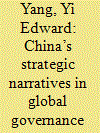

|
|
|
|
|
| Summary/Abstract |
Beijing has long sought to shape global narratives about China. The Xi Jinping administration not only continued that effort but also added an entirely new dimension: it now seeks to use discourse power, particularly through formulating and promoting strategic narratives, to reshape the international system itself. Drawing upon social identity theory (SIT) and strategic narratives framework, this study shows that Beijing employs a multifaceted narrative strategy to redefine existing norms or create new ones in varied global governance domains. A theoretical framework is presented to explain the strategy and subsequently applied to illustrate China’s strategic narratives at the international system level and in three global governance areas, i.e., climate change, human rights, and Internet governance.
|
|
|
|
|
|
|
|
|
|
|
|
|
|
|
|
| 4 |
ID:
178760


|
|
|
|
|
| Summary/Abstract |
Drawing on an original dataset of Chinese protests, this article documents an evolving relationship between state coercive capacity and overt repression across administrations. Specifically, it finds that under Hu Jintao and Wen Jiabao (2003–2012) protests in provinces with higher coercive capacity were less likely to meet with a crackdown, whereas the relationship between capacity and repression reversed during the first three years of Xi Jinping’s rule (2013–2015). Although the study demonstrates that the two periods were on average very different, change-point analysis reveals that the inflection point toward a harder line came already in the late Hu-Wen era. The Xi administration’s policies should therefore perhaps be understood more as a manifestation than a cause of shifts in the country’s social control.
|
|
|
|
|
|
|
|
|
|
|
|
|
|
|
|
| 5 |
ID:
178761
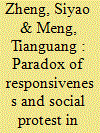

|
|
|
|
|
| Summary/Abstract |
Prior studies regard responsiveness as an effective institution for Chinese government to mitigate social protests based on the premise that citizens adopt more institutionalized channels as soon as the regime makes it available. We challenge this notion by arguing that institutionalized and noninstitutionalized channels are not substituting but complements, and improving responsiveness to institutionalized participation may ironically lead to more protests. We collected a unique dataset and employed machine-learning to measure the quality of local responsiveness. We find that improving responsiveness has a positive effect on protests and identify updating citizens’ beliefs on repression as major mechanism. The findings suggest the availability of new institutionalized channels may not have the intended substitutive effects on noninstitutionalized participation, and thus authoritarian co-optation could have unintended consequences.
|
|
|
|
|
|
|
|
|
|
|
|
|
|
|
|
| 6 |
ID:
178758
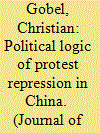

|
|
|
|
|
| Summary/Abstract |
Why do China’s authorities repress some protests, but not others? By how much do crowd size, violent tactics and protest location increase the likelihood of repression? Based on a newly available dataset of more than 70,000 protest events collected from social media, this article tests three competing explanations of protest repression in China. It finds that repression is closely correlated both with the cost of concessions for local governments and protest intensity. A small-scale and peaceful labor protest in an urban locality very seldom encounters repression, but rural riots against land grabs, evictions or environmental pollution are nearly certain to experience state-sanctioned violence or arrests even if the number of participants is low.
|
|
|
|
|
|
|
|
|
|
|
|
|
|
|
|
| 7 |
ID:
178782
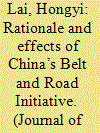

|
|
|
|
|
| Summary/Abstract |
The existing literature suggests that China’s rationale for the belt and road initiative was to stimulate infrastructural investment abroad and thus economic growth at home, foster economic ties with Eurasia, and counter the US pivot to Asia. Employing a domestic political economy perspective, this article suggests that the Belt and Road Initiative (BRI) aimed to address China’s three following vulnerabilities that could derail its economic growth and threaten its political regime—industrial surplus capacity, massive imports of energy through maritime transport instead of safer land routes, and under-development of the western region. Addressing these vulnerabilities helps to sustain China’s economic model characterised by heavy reliance on investment and exports, protection of state firms, and massive energy input. Post-2012 data suggest that the BRI has partially mitigated these three vulnerabilities.
|
|
|
|
|
|
|
|
|
|
|
|
|
|
|
|
| 8 |
ID:
178763


|
|
|
|
|
| Summary/Abstract |
When President Trump-led America abandoned the global leadership, China casted itself as the global leader in response to COVID-19, placing challenges to the US-led world order and liberal globalization. China’s rhetoric, however, has not matched its actions in comprehensively providing global public goods and developing universally accepted values. As neither the US and China have taken the global leadership that most countries can trust and count on, the world is in the danger of moving toward the vicious power rivalry, hampering the multilateral responses to global crisis such as COVID-19.
|
|
|
|
|
|
|
|
|
|
|
|
|
|
|
|
| 9 |
ID:
178770


|
|
|
|
|
| Summary/Abstract |
This article examines the contradictory outcomes of China’s rural reform since 1978. It traces four periods of rural reform policies through cyclical rounds of policy implementation, structural transformations, and economic, social, and environmental outcomes. The analysis reveals that contradictory outcomes are embedded within conflicting goals framing rural reform policies, specifically goals to modernize China’s rural regions and fair resource allocation among its inhabitants. In addition, the Chinese central government has repeatedly resorted to a top-down, campaign-style approach, creating conflicting objectives between short-term quota fulfillment and sustainable structural adjustment policies. The research suggests that the socio-environmental contradictions emerging from rural transformations in China must be viewed within the global political economic context that favors growth oriented, efficiency-based development strategies.
|
|
|
|
|
|
|
|
|
|
|
|
|
|
|
|
| 10 |
ID:
178767
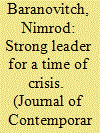

|
|
|
|
|
| Summary/Abstract |
Seeking to explain the reasons for the swift shift from collective leadership to strongman rule during Xi Jinping’s early years in office, this article argues that it was the result of a widely shared consensus among China’s ruling elite that the regime was facing a severe crisis that necessitated a return to such rule. This argument challenges the widely held view that the dramatic centralization of power in Xi’s hands was the result mainly of his individual personality, motives, and actions. While many of the factual details that this article presents are not new, it is the first to systematically integrate many of these facts to create a coherent explanation of China’s surprising abandonment of the collective leadership model that goes beyond Xi’s individual role.
|
|
|
|
|
|
|
|
|
|
|
|
|
|
|
|
|
|
|
|
|